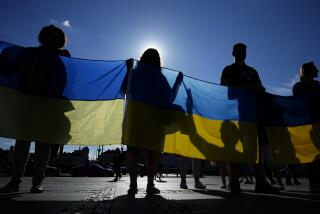Nuclear Scare Is the Means, Not an End : North Korea: Survival of his regime is Kim Il Sung’s motive; how much is the U.S. willing to pay him to stop the program?
The North Korean government appears intent on forcing its way into the nuclear weapons club. In order to stop or at least delay North Korea’s program, U.S. policy must be based on an appreciation of four aspects of North Korea’s nuclear diplomacy.
First, decisions concerning nuclear weapons or Pyongyang’s relations with the United States are made by Kim Il Sung. Nuclear diplomacy is the “Great Leader’s” creation. Those who claim that there is a debate within Kim’s inner circle have yet to provide any evidence to this effect. The Great Leader’s voice continues to be the only one that matters.
The second aspect of North Korea’s nuclear diplomacy derives from Kim Il Sung’s view of the world. Kim thinks in terms of objective factors, though he tends to confuse facts with legends created by the North Korean propaganda apparatus. Kim is convinced his regime can exist only in its current form. Reform cannot be allowed because as events in East Germany, one of North Korea’s closest friends, proved, reform cannot be controlled.
The third component of Pyongyang’s nuclear diplomacy is the fact that North Korea cannot be coerced by economic sanctions. Economic sanctions focus great hardships on the weakest segments of a society. Pyongyang is indifferent to and even encourages the suffering of the average North Korean.
The fourth component is how Kim intends to play a hand whose weakness cannot be exaggerated. A weak hand compels a pragmatist to bluff or cheat. Kim knows that no one is currently prepared to call his bluff or punish him for cheating. The only consequence that matters would be a direct attack on the Pyongyang regime.
Kim Il Sung believes that relations between his regime and the United States can never be normalized. He also believes that the greatest threat to his regime is posed from outside, not inside, North Korea. Thus, the regime must deal with foreign threats before they become factors in the domestic political equation.
Against this background, North Korea’s nuclear diplomacy becomes transparent. The primary objective is not, as many may think, to develop a nuclear weapon. Kim has used nuclear diplomacy before. In 1981 North Korea proposed that a “nuclear-free peace zone” be established on the Korean peninsula. The target was, of course, the elimination of U.S. forces and nuclear weapons in South Korea.
In June, 1986, six months after signing the non-proliferation treaty, North Korea announced that it would refrain from testing, producing, stockpiling and introducing nuclear weapons on its territory. The purpose of these pledges is not to inhibit North Korea’s nuclear weapon program. Instead, they are part of a diplomatic strategy that permits Kim to create a crisis.
The purpose of this strategy is to focus attention on the trumped-up crisis, which deflects interest from the central issue: the survival of the Kim Il Sung regime in its present form. Kim is looking for a way to focus foreign pressure on issues North Koreans can control. At the same time, Kim is attempting to sustain his regime by obtaining financial rewards for living up to his own promises.
U.S. policy toward North Korea should not, therefore, focus on nuclear weapons at the expense of what for Pyongyang is the larger issue. For the United States, the central issue is whether the Clinton Administration is prepared to support the Kim Il Sung regime in exchange for North Korea’s compliance with its commitments to the non-proliferation treaty.
If the Clinton Administration is able to live with the current North Korean regime, then the question is to determine Pyongyang’s price for staying out of the nuclear weapons club. Thus the challenge for the Administration is to create a compensation package that will stimulate the appropriate counterproliferation response in Pyongyang. In other words, Kim Il Sung might respond to a bribe of massive proportions if it is offered in the appropriate fashion. The architect of Pyongyang’s nuclear diplomacy appears ready to accept no other solution.
Diplomacy is the art of giving each side what it wants. Only one solution will satisfy both sides: The United States buys out Kim Il Sung’s nuclear option, which means Pyongyang gets money to sustain the current regime a while longer. The “Great Leader” is a great pragmatist.
The other solution is to stop Pyongyang’s nuclear weapons program by bringing down the current North Korean regime. If this is U.S. policy, the issue is greater than a non-proliferation question.
More to Read
Sign up for Essential California
The most important California stories and recommendations in your inbox every morning.
You may occasionally receive promotional content from the Los Angeles Times.










